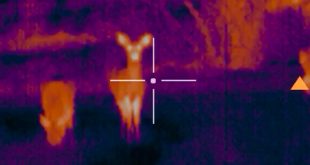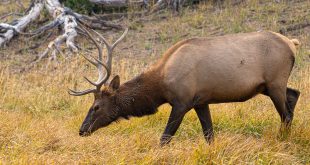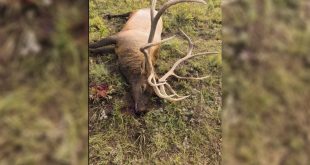The first time that I realized that high-altitude pockets and basins were good places to search for trophy elk was as an 18-year old guide. I was guiding in 1967 for a second generation outfitter, Keith Stilson. Keith’s hunting area was up in the Gros Ventre River country. Ravaged by fire at the turn of the century, the country’s new growth left it with plenty of grassy meadows and patches of timber for cover. It didn’t’ take long for the Gros Ventre’s elk population to explode. Even now, 100 years later, it’s a wilderness area and still ideal elk-hunting country.
I was guiding and hunting the typical meadows and clearings for elk in late September, right during the peak of the rut. My two hunters each harvested branch-antlered bulls and good four-point mule deer. I was done guiding for the hunt, so when Keith came in one night with the news his hunters had both taken bulls in the Ram’s Horn, my ears perked up. I said that the Ram’s Horn was too high in elevation to have elk. Keith just smiled and said he needed a little help packing out the bulls.
With four packhorses in tow that next morning we started a long, steep ride to retrieve the bulls. Our horses scratched their way up a steep trail through the Ram’s Horn basin, climbing higher and higher past bedded bighorn sheep until we stood at the top of the world. I still remember the horses blowing on top and looking down to the creek bottom below, thinking elk can’t live here.
Then I turned to the left and there, on top of the peak looking like a landmark, was a 350-class bull elk rack. The rack was tipped up on its back points with its skull pointing toward the clouds. Obviously, someone had placed the bull’s antlers in that position. Turning to Keith, I asked, “What’s a bull like that doing up here in sheep country?”
Keith took the pipe from his mouth and smiled. He told me that many years before, one of his hunters harvested the bull right where the antlers stood. Believe it or not, the hunter didn’t care about the rack. Meat was the focus of the hunt and the antlers were of no value to the hunter. Keith had left them standing as a monument and a sign where to dump off the peak down through a slide into the next set of steep basins, because if a hunter went the wrong way coming down in the dark off the peak, things got western real fast; there’s no second chances in country that rugged.
After admiring the rack, Keith and I dropped off down a steep snowslide and into a rocky, isolated pocket. It wasn’t long before we heard bulls bugling and cows mewing in the bottom of the basin. With an elevation of 11,000 feet, the pocket contained scrub pines scattered through the boulder-filled bottom. The only vegetation I saw was small clumps of grass that grows in high-mountain basins. Even after the two hunters had harvested elk there the previous day, the pocket still held elk.
After loading the two bulls on the four packhorses, Keith and I followed a barely visible trail that fell nearly straight down and out to the creek bottom miles below. Keith told me that the pocket always held a couple of good bulls during the fall. After that jaunt, I changed my view on what type of country typically holds elk.
Because they’re too busy hunting the typical elk terrain, hunters often overlook high-mountain pockets and basins. These pockets and basins are high-elevation holes carved out of the sides of peaks by glaciers long ago. Look for characteristics like timber at the base of these pockets and basins, a spring coming out of the base of the rim, and scattered meadows of high-elevation bunchgrass. Elk seem to like this short, clumpy grass found above 9,600 feet. One of these rough and rocky pockets or basins is all a bull needs to make it through the fall. Most high mountain mule deer hunters know about this type of terrain, as mature mule deer bucks also like to call these areas home.
Good luck this season and enjoy your hunts!
-Mike Eastman
 Eastmans' Official Blog | Mule Deer, Antelope, Elk Hunting and Bowhunting Magazine | Eastmans' Hunting Journals
Eastmans' Official Blog | Mule Deer, Antelope, Elk Hunting and Bowhunting Magazine | Eastmans' Hunting Journals







elk can be anywhere-esp dark timber after the guns start going off.